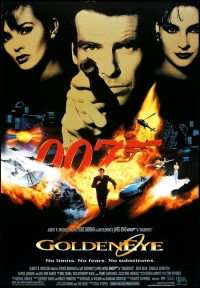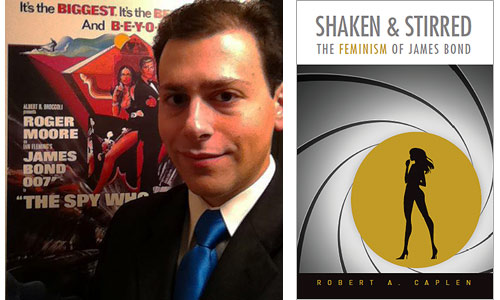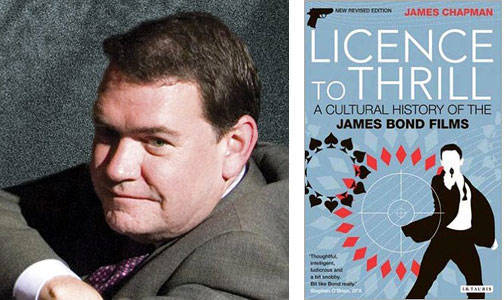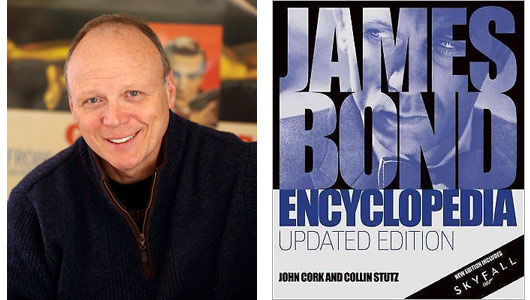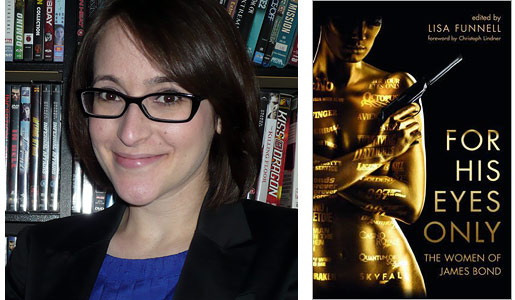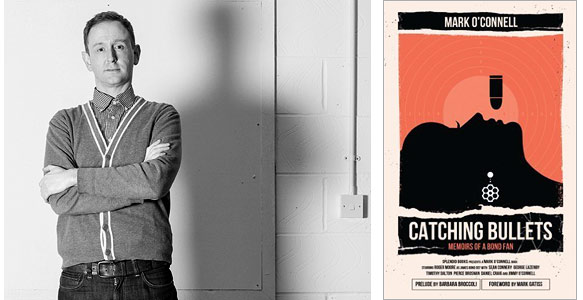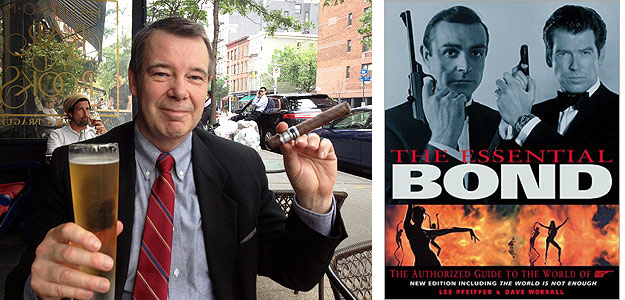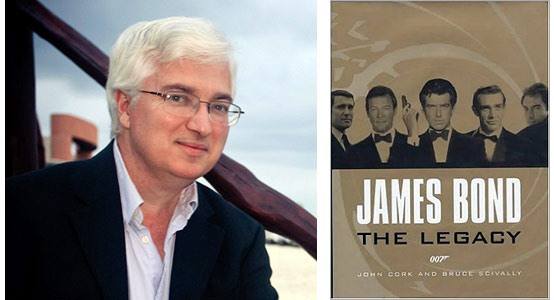“Had GoldenEye failed, that would have been it for 007.” — John Cork
The Digital Bits is pleased to present this retrospective commemorating the 20th anniversary of the release of GoldenEye, the 17th (official) cinematic James Bond adventure and, most notably, the first to star Pierce Brosnan as Agent 007.
As with our previous 007 articles (available here, here, here, and here), The Bits continues the series with this retrospective featuring a Q&A with an esteemed group of James Bond authorities who discuss the virtues and shortcomings of GoldenEye and analyze whether or not the passage of time has been kind to the film. [Read on here...]
The interviews were conducted separately and have been edited into a “roundtable” conversation format.
The participants…
Robert A. Caplen is an attorney and the author of Shaken & Stirred: The Feminism of James Bond (Xlibris, 2010).
James Chapman is a Professor of Film Studies at the University of Leicester and is the author of Licence to Thrill: A Cultural History of the James Bond Films (Tauris, 2007). His other books include Inside the Tardis: The Worlds of Doctor Who—A Cultural History (Tauris, 2006), Saints and Avengers: British Adventure Series of the 1960s (Tauris, 2002), and (with Nicholas J. Cull) Projecting Empire: Imperialism and Popular Cinema (Tauris, 2009). Chapman is also a Council member of the International Association for Media and History and is Editor of the Historical Journal of Film, Radio and Television.
John Cork is the author (with Bruce Scivally) of James Bond: The Legacy (Abrams, 2002). He also wrote (with Maryam d’Abo) Bond Girls Are Forever: The Women of James Bond (Abrams, 2003) and (with Collin Stutz) James Bond Encyclopedia (DK, 2007). He is the president of Cloverland, a multi-media production company, producing documentaries and supplemental material for movies on DVD and Blu-ray, including material for Chariots of Fire, The Hustler, and many of the James Bond and Pink Panther titles. Cork also wrote the screenplay to The Long Walk Home (1990), starring Whoopi Goldberg and Sissy Spacek. He recently wrote and directed the feature documentary You Belong to Me: Sex, Race and Murder on the Suwannee River for producers Jude Hagin and Hillary Saltzman (daughter of original Bond producer, Harry Saltzman); the film is available on iTunes, Google Play and other streaming platforms.
Bill Desowitz is the author of James Bond Unmasked (Spies, 2012). He is the owner of Immersed in Movies, a contributor to Thompson on Hollywood at Indiewire and contributing editor of Animation Scoop at Indiewire. He has also contributed to the Los Angeles Times and USA Today.
Lisa Funnell is the editor of For His Eyes Only: The Women of James Bond (Wallflower, 2015). She is Assistant Professor, Women’s and Gender Studies Program and Affiliate Faculty, Film and Media Studies Program at the University of Oklahoma. Her other books include Warrior Women: Gender, Race, and the Transnational Chinese Action Star (State University of New York, 2015) and (with Philippa Gates) Transnational Asian Identities in Pan-Pacific Cinemas: The Reel Asian Exchange (Routledge, 2011).
Mark O’Connell is a punditeer, the grandson of Bond producer Cubby Broccoli’s chauffeur, and the author of Catching Bullets: Memoirs of a Bond Fan (Splendid Books, 2012).
Lee Pfeiffer is the author (with Philip Lisa) of The Incredible World of 007: An Authorized Celebration of James Bond (Citadel, 1992) and The Films of Sean Connery (Citadel, 2001), and (with Dave Worrall) The Essential Bond: The Authorized Guide to the World of 007 (Boxtree, 1998/Harper Collins, 1999). He also wrote (with Michael Lewis) The Films of Harrison Ford (Citadel, 2002) and (with Dave Worrall) The Great Fox War Movies (20th Century Fox Home Entertainment, 2006). Lee was a producer on the Goldfinger and Thunderball Special Edition LaserDisc sets and is the founder (with Dave Worrall) and Editor-in-Chief of Cinema Retro magazine, which celebrates films of the 1960s and 1970s and is “the Essential Guide to Cult and Classic Movies.”
Bruce Scivally is the author (with John Cork) of James Bond: The Legacy (Abrams, 2002). He has also written Superman on Film, Television, Radio & Broadway (McFarland, 2006), Billion Dollar Batman: A History of the Caped Crusader on Film, Radio and Television from 10¢ Comic Book to Global Icon (Henry Gray, 2011), and Dracula FAQ: All That’s Left to Know About the Count from Transylvania (Backbeat, 2015). As well, he has written and produced numerous documentaries and featurettes that have appeared as supplemental material on LaserDisc, DVD and Blu-ray Disc, including several of the Charlie Chan, James Bond, and Pink Panther releases. He is the Vice President of New Dimension Media in Chicago, Illinois.
And now that the participants have been introduced, might I suggest preparing a martini (shaken, not stirred, of course) and cueing up the soundtrack album to GoldenEye, and then enjoy the conversation with these James Bond authorities.
---
Michael Coate (The Digital Bits): In what way is GoldenEye worthy of celebration on its 20th anniversary?
Robert A. Caplen: Has it really been twenty years since Pierce Brosnan ended the Bond franchise’s longest hiatus?! Timothy Dalton’s last film, Licence to Kill, was released in June 1989; the Berlin Wall came down five months later. GoldenEye, with its lavish title sequence that depicts the toppling of the Soviet Union and global geopolitical changes, ushered in a new era by introducing Bond and audiences to the post-Cold War era. It marked the appearance of Dame Judy Dench as M, who pulls no punches and criticizes Bond’s cavalier, sexist, and misogynist attitude as a “relic of the Cold War.” Restoring the luxury, glamour, and peccadilloes of Agent 007 in a manner that is reminiscent of the Sean Connery era while simultaneously placing James Bond under the supervision of a female authority figure, GoldenEye is undoubtedly an important installment in the James Bond oeuvre and, arguably, Pierce Brosnan’s most successful mission.
James Chapman: GoldenEye might not be the best Bond movie ever but it is one of the most important in the series’ history as it was the film that revived the franchise after the hiatus of the early 1990s. The reasons for that have been well documented and perhaps we needn’t go over them again here. The legal disputes between Eon/Danjaq and MGM were part of it, but I think a more fundamental issue was the feeling that Bond had lost ground to other action-adventure franchises: Lethal Weapon, Die Hard, Speed, the Schwarzenegger and Stallone films. Licence to Kill was down at the box-office and did very poorly in the US market (about $35 million—way below Lethal Weapon 2 and Batman that summer). It’s hard to credit it now, but there was a lot of speculation in the early 1990s that Bond was finished—some very respected film critics and industry figures were suggesting that Bond was a relic of the past. And the longer the hiatus went on, the more plausible that view seemed…. GoldenEye did very good box-office—over $100 million in the US market, which by then had become the benchmark for a major success, and around $331 million worldwide—and proved the naysayers wrong. I think its importance was that it proved there was still a market for a Bond movie. One of the things I like most about it is that it addresses the charges that had been made against Bond—that he was an outmoded and chauvinistic heroic archetype—by voicing them itself through the agency of a female authority figure (i.e. Judi Dench’s “sexist, misogynist dinosaur, a relic of the Cold War” line).
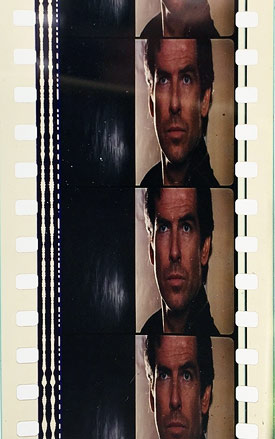 John Cork: GoldenEye saved James Bond and MGM. 007’s darkest days were from 1989 until November 1995. In 1990, MGM (which owned United Artists) collapsed in on itself. Raped of much of its library by Ted Turner earlier in the decade and bought through a questionable process of future profit dismemberment by Giancarlo Parretti, Cubby Broccoli and Michael Wilson found Bond trapped at a studio that could no longer operate as a viable business. The trades were filled with stories of the Bond franchise being put up for sale and even predictions that—after the disappointing grosses of Licence to Kill and the fall of the Soviet Empire—007 was dead. After Parretti and his studio team lead by Alan Ladd Jr. left, MGM was owned by the bank Crédit Lyonnais and run by Frank Mancuso Jr. and John Calley. The plan was simple: prove to potential buyers that MGM’s assets were of much greater value than MGM’s debts, and that it was well-positioned to make new hit movies. The industry had serious doubts. In 1993, the studio had failed to revive the Pink Panther series with Son of the Pink Panther, and available cash to produce new films was limited. As far as James Bond went, the studio had no faith in Timothy Dalton’s ability to reprise his role as Bond, forcing him to retire from the role. This meant casting a new Bond, investing heavily in a new film and finding a workable relationship with Cubby Broccoli, Michael Wilson and Barbara Broccoli. It was no secret at the time that some inside MGM wanted to push Danjaq out of the way, hire a producer like Joel Silver, and control the film internally. The studio decided to position the film as a summer blockbuster for 1995, the launch for what the studio hoped would be a series of hit films in the second half of 1995 that would relaunch MGM as a valuable property that could be sold for a very high price. After the success of Fox’s True Lies in 1994, MGM concluded that GoldenEye needed a tighter script, bigger action and more time. Now, instead of launching MGM’s season of hits, it would come in the middle. Mancuso and Calley had bet everything on the fall of 1995. The studio would release six films from September to December, and literally everything was on the line. Three of the films were bombs: Hackers, Showgirls and Cutthroat Island. Both Get Shorty and Leaving Las Vegas made money for the studio. As far as the industry was concerned, only one film mattered: GoldenEye. The fate of the studio rested in the hands of James Bond, and GoldenEye’s success would not only confidently state that there was profit to be wrung from future 007 films, but it would drive up the value of the Bond catalog. GoldenEye proved all the doubters wrong. Bond’s continued relevance, it turned out, had little to do with Cold War politics or studio equity. It had everything to do with quality. Everyone involved in making GoldenEye was hungry, and it shows. The film is also the introduction of Barbara Broccoli as a key creative voice in the Bond team, the launch of Pierce Bronsan’s career as Bond, and the best evidence that the creative team could take 007 beyond the decades that defined him.
John Cork: GoldenEye saved James Bond and MGM. 007’s darkest days were from 1989 until November 1995. In 1990, MGM (which owned United Artists) collapsed in on itself. Raped of much of its library by Ted Turner earlier in the decade and bought through a questionable process of future profit dismemberment by Giancarlo Parretti, Cubby Broccoli and Michael Wilson found Bond trapped at a studio that could no longer operate as a viable business. The trades were filled with stories of the Bond franchise being put up for sale and even predictions that—after the disappointing grosses of Licence to Kill and the fall of the Soviet Empire—007 was dead. After Parretti and his studio team lead by Alan Ladd Jr. left, MGM was owned by the bank Crédit Lyonnais and run by Frank Mancuso Jr. and John Calley. The plan was simple: prove to potential buyers that MGM’s assets were of much greater value than MGM’s debts, and that it was well-positioned to make new hit movies. The industry had serious doubts. In 1993, the studio had failed to revive the Pink Panther series with Son of the Pink Panther, and available cash to produce new films was limited. As far as James Bond went, the studio had no faith in Timothy Dalton’s ability to reprise his role as Bond, forcing him to retire from the role. This meant casting a new Bond, investing heavily in a new film and finding a workable relationship with Cubby Broccoli, Michael Wilson and Barbara Broccoli. It was no secret at the time that some inside MGM wanted to push Danjaq out of the way, hire a producer like Joel Silver, and control the film internally. The studio decided to position the film as a summer blockbuster for 1995, the launch for what the studio hoped would be a series of hit films in the second half of 1995 that would relaunch MGM as a valuable property that could be sold for a very high price. After the success of Fox’s True Lies in 1994, MGM concluded that GoldenEye needed a tighter script, bigger action and more time. Now, instead of launching MGM’s season of hits, it would come in the middle. Mancuso and Calley had bet everything on the fall of 1995. The studio would release six films from September to December, and literally everything was on the line. Three of the films were bombs: Hackers, Showgirls and Cutthroat Island. Both Get Shorty and Leaving Las Vegas made money for the studio. As far as the industry was concerned, only one film mattered: GoldenEye. The fate of the studio rested in the hands of James Bond, and GoldenEye’s success would not only confidently state that there was profit to be wrung from future 007 films, but it would drive up the value of the Bond catalog. GoldenEye proved all the doubters wrong. Bond’s continued relevance, it turned out, had little to do with Cold War politics or studio equity. It had everything to do with quality. Everyone involved in making GoldenEye was hungry, and it shows. The film is also the introduction of Barbara Broccoli as a key creative voice in the Bond team, the launch of Pierce Bronsan’s career as Bond, and the best evidence that the creative team could take 007 beyond the decades that defined him.
Bill Desowitz: GoldenEye is significant as a turning point with the introduction of Pierce Brosnan and a popular return to a more classic Bond. After a six-year hiatus (the longest in franchise history), fans craved Bond and Brosnan delivered a back to basics approach after the dramatic extreme of Timothy Dalton’s Licence to Kill. With Michael Wilson and Barbara Broccoli taking over as producers, there was a celebration of the familiar Bond trappings with a renewed sense of action, style and humor, and Brosnan was happy to oblige. At the same time, they successfully answered the question: How did Bond fit in a post-Cold War world? And new director Martin Campbell made it fast-paced and fun. Although Brosnan was initially supposed to succeed Roger Moore, his delay worked out for the best and he was a better Bond.
Lisa Funnell: GoldenEye is an important film because it helped to (re)ignite popular interest in the franchise after a six-year hiatus. The film not only marks the return of the iconic hero to the silver screen but also more pointedly asks if the world still needs James Bond. GoldenEye relays the impression that the world around Bond has changed particularly in terms of its gender politics. This is most evident in the casting of Dame Judi Dench in the role of M, Bond’s boss, as well as the comments she makes to Bond such as: “I think you’re a sexist, misogynist dinosaur. A relic of the Cold War, whose boyish charms, though lost on me, obviously appealed to that young girl I sent out to evaluate you…If you think I don’t have the balls to send a man out to die, your instincts are dead wrong. I’ve no compunction about sending you to your death. But I won’t do it on a whim.” In this (drop-the-mic) speech, M also draws attention to changes in the geopolitical landscape with the fall of the Soviet Union and the end of the Cold War. It draws attention to the threat of individual actors/cells rather than sovereign nations to the safety of Britain and the world. And so the film answers its own question by demonstrating that we still need James Bond to save the day—a hero who is defined by instincts, touch, and interpersonal relationships. This question has been raised again twenty years later in SPECTRE and broadly applied to the 00 program in light of the digital turn and advances in surveillance technologies like drones.
Mark O’Connell: It marked the official changing of the guard at Eon Headquarters with Barbara Broccoli and Michael G Wilson officially taking the producer reins, a new actor as Bond and a much needed cinematic Vodka martini after a long, long Bond film drought. It also was the cherry bursting moment for a vital new wave of Bond fans and general audiences. To a lot of people GoldenEye is their Dr. No or On Her Majesty’s Secret Service. And if that is their entry point they are not wrong. Too much elitist shepherding happens in Bond fandom. Whilst reworking that recognizable Bond film template, GoldenEye thankfully shatters the templates of what a Bond fan should like and not like.
Lee Pfeiffer: GoldenEye is the film that rescued Bond from the brink of cinematic extinction. At the time producer Cubby Broccoli was at odds with the management team of United Artists, who he blamed for the relatively light domestic grosses for Licence to Kill in 1989. Broccoli swore he would not make another Bond film until a new management team took over. Ultimately, a new team headed by Alan Ladd Jr. and Frank Mancuso took the reins of the struggling studio which was on the brink of bankruptcy. They backed Cubby’s desire to bring Bond back even though the smart money said 007 was an outdated relic of the Cold War. I went to dinner in New York with Cubby and his wife Dana around the time they were preparing for the new film. Cubby said that he was bowing out of the day-to-day production duties and relegating the franchise to the care of “the kids,” meaning his daughter Barbara and stepson Michael G. Wilson. Both of them had long experience working on the franchise and Cubby and Dana felt confident that they could make Bond work again with a new generation of moviegoers. He also rattled off a top secret list of actors that had been screen tested for the role before stating the obvious: the vast majority of people wanted Pierce Brosnan. Actually, Brosnan had been signed for the role in 1986 when Roger Moore retired but NBC did him dirty by renewing his TV series Remington Steele, thus taking him out of the running for the part. Timothy Dalton had replaced him but after a gap of five years off screen, Dalton bowed out and Brosnan finally got his chance. GoldenEye, although modestly budgeted by today’s standards, was still considered a major risk. However, when the teaser trailer was screened months ahead of the opening, confidence was built based on wildly enthusiastic audience reactions. The film opened in New York City at Radio City Music Hall for a gala premiere one week before the British premiere. At the UK premiere, I rather cautiously broached the subject of the U.S. grosses with Michael Wilson. In those days, news traveled slowly so I didn’t know how the film was performing in the States. Wilson smiled broadly and said that the grosses were of blockbuster status. The rest of the world followed suit and proved that there was room indeed for a post-Cold War 007.
Bruce Scivally: GoldenEye is worthy of celebration for being the Bond film that brought 007 into the modern era. Licence to Kill seemed like a glorified TV episode, like Miami Vice on steroids, with an aesthetic more befitting the ’70s than the late 80s. GoldenEye, with a much bigger budget, managed to keep all the elements audiences expected from Bond and make them seem fresh—no small feat for a series then entering its 33rd year. On top of that, the film introduced Pierce Brosnan as James Bond. That alone is cause for celebration. The film also ushered in a new wave of spy mania, with spy films hitting movie screens and spy-themed shows on television in a quantity last seen thirty years earlier, when the one-two punch of Goldfinger and Thunderball made spies the coolest anti-heroes of the 1960s.
Coate: When did you first see GoldenEye and what was your reaction?
Caplen: I was in high school when GoldenEye was released and remember thoroughly enjoying the film. For me, GoldenEye had the feel of a Sean Connery film that was refreshing and exciting. I also remember the television infomercials for the VHS collector’s edition of the films that were linked to the film’s release. I ultimately had at my fingertips a personal library of 007 films, helping pave the way to my becoming a 007 scholar.
Chapman: The Odeon cinema in Sheffield when it was released in 1995. My first thought was simply to be thankful that there was a new Bond movie after six and a half years. And then to be thankful that it was a pretty decent Bond movie—recognizable as a Bond movie and not going down the Lethal Weapon/Die Hard route. I thought the jury might be out on Pierce Brosnan—I’d liked Timothy Dalton’s interpretation of Bond—though I warmed to him. I didn’t think GoldenEye was as good an introduction for Pierce as The Living Daylights had been for Tim. I thought it took a while to get going and that the first half was quite loosely structured. But it really picked up with the St. Petersburg scenes from the Statue Park through to the tank chase…. I have a “theory” (that might be putting it too strongly) that the pre-title sequence of GoldenEye was in a sense writing Dalton’s Bond out of the series’ history, just as Connery’s return in Diamonds seemed to be concerned to erase the memory of Lazenby and On Her Majesty’s Secret Service. Hence the pre-title of GoldenEye is set in 1986—the year that Brosnan nearly became Bond but was thwarted at the eleventh hour by his Remington Steele contract. It’s as if the film is saying that Brosnan should have been Bond all along.
Cork: I first saw about 40 minutes of cut footage from GoldenEye at Leavesden in the summer of 1995 when I was working on the behind-the-scenes documentaries for the Goldfinger and Thunderball LaserDisc releases. Lee Pfeiffer and I got asked if we wanted to see the assembled footage so far and we jumped at the chance. The first time I saw the entire film was at a sneak screening in Hollywood that was quasi-open to the public. I think I saw it three more times at press screenings before I went to New York for the premiere at Radio City Music Hall! As some know, I had been working with the producers on another project during the development of GoldenEye. I would see Michael France in the office occasionally. After I had finished my work, I would still see Barbara and Michael in Los Angeles when something would bring me into the Danjaq offices, and I would get little updates on what was happening. I got to know Bruce Feirstein during his tenure working on the film, and he, like the late Michael France, is a writer I admired. So, even though I had absolutely nothing to do with GoldenEye, I felt personally invested in it. I had seen the hard work, the nerves, and witnessed some of the normal tug of war with the studio over the development process. So I was really rooting for the film. My reaction was not only that of a fan, but it was like I was watching a friend’s child in a competition: I was rooting for every scene, loved what I was seeing, but constantly on edge about any aspect that I thought could be better. It really took me about six viewings before I could watch the film and completely enjoy it just as a film.
Desowitz: I saw it opening night in Westwood and couldn’t have been more pleased. Brosnan proved that Bond was still relevant with a sense of pride and joy.
Funnell: I first watched GoldenEye at home with my dad. The film was his Christmas gift and we watched it soon after it was unwrapped. Although I cannot recall my exact reaction, two things have always resonated with me. The first is how perfectly suited (pun intended!) Pierce Brosnan was for the role; he looks and feels like James Bond unlike actor Timothy Dalton before him. The second is how differently women are depicted in the film. I love the casting of Dame Judi Dench for the role as M and her questioning of the sexual politics of the franchise. Her critique is supported through the characterization of Natalya Simonova who demands a lot from Bond. With this film, I felt that something had changed in the gender politics of the franchise and I liked this new turn.
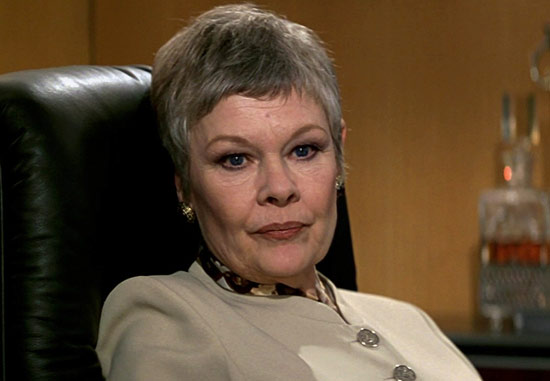
O’Connell: I first saw GoldenEye the week it came out and loved it. The atmosphere in the cinema was like a circus—with cheers, chat and a lot of clapping at the right times. That interaction is normally my idea of movie-watching hell, but the crowd were behind the film from those two white dots onwards. I loved that it was a Bond film again—not for the stunts or the music or the big budget caper of it all, but the ridiculous things like that Binder credit font was back, big set British production work was back, the branding of Bond was back (that black and white teaser and the Tina Turner track), film heroes in almost anachronistic shirt and ties were back, society launch parties gone wrong were back and expert model work and remote control helicopters were back!
Pfeiffer: I first saw [the completed] GoldenEye at the Radio City Music Hall premiere. I must confess, I was not enamored with it. Neither were most of the die-hard Bond scholars who were with me that night. Perhaps my expectations were too high, but I thought the overall story line was somewhat smaller-than-life. The villain wants to create chaos in the worldwide financial communities. I thought that was a rather bland concept, although it did prove to be somewhat prophetic. Today, that threat would seem more unnerving as the world is far more linked by on-line transactions. I also thought the musical score by Eric Serra was bland and boring, and that the character of Boris—played by young up-and-comer Alan Cumming, was badly used in the script—particularly his absurd death sequence. However, I’ve seen it a couple of times since it opened in 1995 and it’s grown on me. The good elements play better and the weak elements don’t seem so bad today. I can see why it appealed to a younger generation at the time and I always felt that Pierce did a sensational job in the role of Bond.
Scivally: My first viewing of GoldenEye was at the AMC Century 14 in Century City, California. I remember being somewhat put-off by the techno-pop music under the gunbarrel, and also a little disappointed that the big pre-credits stunt sequence relied on CGI instead of, as with previous Bond films, a dangerous stunt done “for real” by life-risking stuntmen. But I loved the theme song and Daniel Kleinman’s title sequence, and enjoyed the “times have changed, but Bond hasn’t” concept of the film. It certainly looked much more lavish than the previous 007 film, had a good script, taut direction by Martin Campbell, and Pierce Brosnan quickly won me over as the new James Bond. But that music... This film ranks with Never Say Never Again for 007 movies almost totally undone by horrible scores. But by the time the film ended, bad music notwithstanding, I enjoyed it, and so did the opening-night audience. I went back to see it, if memory serves right, two more times in the theater.


